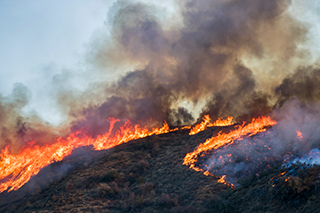Introduction
Dioxins

Dioxins are a group of chemically related compounds, and they are persistent in the environment. This group includes polychlorinated dibenzo para dioxins (PCDDs) and polychlorinated dibenzofurans (PCDFs). The most toxic dioxin is known as TCDD, and it was a component of Agent Orange, an herbicide used in the Vietnam War. Certain dioxin-like polychlorinated biphenyls (PCBs) with similar toxic properties are also included under the term dioxins.
People are exposed to dioxins primarily by eating contaminated food, in particular animal products where dioxins are absorbed and stored in fat tissue. More than 90% of human exposure is through meat, dairy products, and fish and shellfish, according to the World Health Organization (WHO).
Before safeguards and regulations were introduced, dioxin releases were a major problem in the United States. The EPA worked with industry to ban products containing dioxin and to curb dioxin emissions. Also, in 1979, the EPA banned the manufacture of products containing PCBs.
However, dioxins break down very slowly and emissions released long ago remain in the environment. Some dioxins are extremely resistant to environmental degradation, and therefore are classified as persistent organic pollutants (POPs).
Dioxin contamination is an increasing problem in some lower-income countries, particularly with uncontrolled burning, and dismantling and recycling of electronic products, such as computers. An important concept is that although dioxins form locally, their environmental distribution is global.
The Science of Dioxins

Dioxins share distinct chemical structures and characteristics. Numerous dioxin-like compounds have been identified that are considered to have significant toxicity and can cause disease.
NIEHS researchers have explored the detailed chemical pathway through which dioxins damage the body. Scientists are now confident that the first step in that process happens when a dioxin binds to an intracellular protein known as the aryl hydrocarbon receptor (AhR), which can alter the expression, or function, of certain genes. The resulting cellular imbalance leads to a disruption in normal cell function and ultimately adverse health effects.
Many other chemicals can bind to AhR. About 400 compounds in the environment act on the body through the AhR receptor. Public health officials around the world are concerned about the combined effects of multiple chemicals that activate the AhR and are developing health standards that consider the fact that people are exposed to mixtures of dioxin-like compounds, not just one at a time.
Dioxins' Impact

The public health threats posed by dioxins were highlighted dramatically in the public consciousness in the late 1970s and early 1980s. Newspapers and television broadcasts were full of stories about ailing veterans who had been exposed to dioxins through Agent Orange, an herbicide and defoliant used in the Vietnam War.
Concerns continue today. Research supported by NIEHS and many other researchers, examining the link between dioxins and serious illnesses, has increased understanding of how certain cancers and other health problems may be associated with exposure to Agent Orange or other herbicides during military service.
Dioxins were also brought to light in 1982, when the town of Times Beach, Missouri, was evacuated because of dioxin contamination. This incident, as well as others, helped spark passage of legislation that created Superfund, the environmental program established to address abandoned hazardous waste sites.
NIEHS administers the Superfund Research Program, which involves a network of university and small business grants that are designed to seek solutions to the complex health and environmental issues associated with the nation's hazardous waste sites. The research conducted by this program is coordinated with EPA, the federal entity charged with cleaning up the worst hazardous waste sites in the country, including those contaminated with dioxins.
Hazards posed by dioxins have diminished in the U.S., as environmental controls reduced the introduction of new industrial sources of dioxin. However, legacy problems persist, and the scientific community works to further reduce exposures and associated health effects.
Assessment of dioxin-like compounds also continues. NIEHS staff consulted with the WHO, in 2022, to review estimates of toxicity for dioxin-like compounds that were established in 2005. The findings of this expert consultation and evaluation were published in a peer-reviewed paper in 2023.
Health Effects
Exposure to dioxins has widespread effects in nearly every vertebrate species, at nearly every stage of development, including in the womb. Once dioxins enter the body, they last a long time because of their chemical stability and their ability to be absorbed by and stored in fat tissue.
Dioxin exposure has been linked to several diseases, including type 2 diabetes, ischemic heart disease, and an acne-like skin disease called chloracne, a hallmark of dioxin exposure. TCDD is known to be a human carcinogen.
Dioxins can cause developmental problems in children, lead to reproductive and infertility problems in adults, result in miscarriages, damage the immune system, and interfere with hormones.
The NIEHS Sister Study evaluated, in 2023, whether dioxin may be associated with breast cancer risk. They used publicly available data on industrial emissions at facilities located near participant's homes to estimate dioxin exposure levels. Then associations between estimated dioxin exposure and breast cancer risk were evaluated. Researchers found that long-term exposure to airborne dioxin emissions within 3 kilometers of participants' residences was associated with increased breast cancer risk. This association was strongest for emissions from municipal solid waste facilities. These findings indicate that living in proximity to industrial emissions facilities may be linked to higher breast cancer rates.
Further Reading
Stories from the Environmental Factor (NIEHS Newsletter)
- Scientific Journeys: Uncovering How Dioxins Affect the Immune System (April 2025)
- Role of Complex Exposures in Breast Cancer Highlighted During Workshop (October 2022)
- How Environmental Exposures May Contribute to Autoimmunity (October 2022)
- Air Pollution and Forever Chemicals Continue to Pose Health Risks (March 2022)
Additional Resources
- Dioxins and Their Effects on Human Health - Key information from the WHO
- Dioxin Mixtures Research - by the National Toxicology Program (NTP) at NIEHS
Related Health Topics
This content is available to use on your website.
Please visit NIEHS Syndication to get started.

